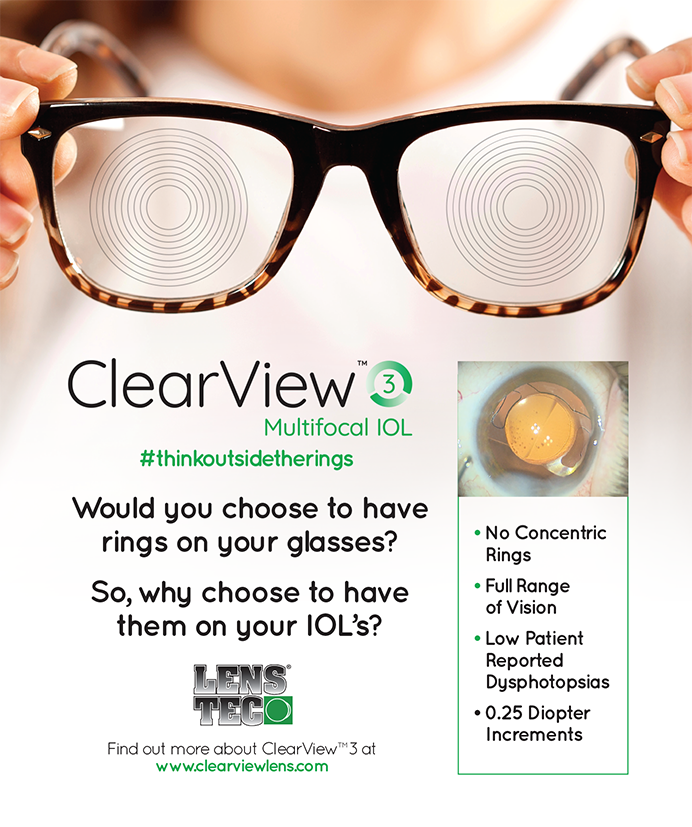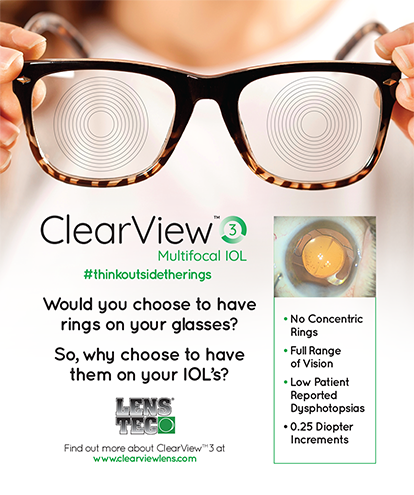A 36-year-old white man presented to my practice with a complaint of gradual vision loss in his right eye that had occurred over the preceding several years. The BCVA in his left eye had been 20/400 since birth, but he said that he had always maintained good functional vision in his right eye, even though he had significant congenital colobomata in both eyes .
According to the patient's childhood records, his right eye had a BCVA of 20/30. He said he had noticed over time a gradual decrease in his visual acuity, and his BCVA was 20/70 at presentation. He had already consulted several ophthalmologists for treatment and was told to defer cataract surgery because of the complex presentation of his right eye and the potential for loss of vitreous and BCVA.
The patient's colobomata took out approximately 4 clock hours of the iris from 4 to 8 o'clock with an absence of the ciliary body and zonules and a C-shaped indentation in the lens. The coloboma extended through the fovea of the left eye and just up to the fovea of the right eye. As a result, there was no significant chance of rehabilitation of the patient's left eye. He had a dense, nuclear sclerotic cataract in both eyes at grade 6 on the Lens Opacification Classification Scale System III (Figure 1).
Being a young man in the work force, he was experiencing difficulty functioning in his daily life. Because he was monocular, however, he was hesitant to undergo surgery for fear of complications.
SURGICAL COURSE
After I counseled the patient on the risks and benefits of cataract surgery, he decided to wait a few months before making a decision. He returned when his visual acuity dropped from 20/70 to 20/100 due to nuclear sclerosis. The patient had lost the ability to drive and work, so he decided to move forward with the procedure. Biometric evaluation included topography, manual keratometry, and measurements with the IOLMaster 500 (Carl Zeiss Meditec Inc.). He had an elevated baseline on the IOLMaster readings without any secondary maxima, and the signal-to-noise ratio was poor to fair. I was not able to capture a good grouping of axial length measurements within 0.02 mm of each other. The scan was suboptimal due to the density of the cataract. I decided to perform an immersion ultrasound in an attempt to obtain a better axial length measurement. Unfortunately, there was a 1.88-mm difference in axial length measurements between the IOLMaster and the immersion ultrasound, which resulted in a 5.50 D difference in the IOL choices. In addition, the patient had atypical anatomy; the depth of his anterior chambers, according to the IOLMaster, was a shallow 1.95 mm. I was cautious about the reliability of the preoperative biometry measurements (Figure 2).
ABERROMETRY
Fortunately, I had previous experience with the ORA System (WaveTec Vison). I explained to the patient that the density of his cataract was compromising the reliability of the preoperative measurements. I explained to him that the device would be an ideal tool in this case, because its Optiwave technology (WaveTec Vision) is designed to provide an accurate intraoperative wavefront aberrometry measurement, thus allowing for a more precise IOL power calculation at the time of surgery. Although I believed that the IOLMaster's measurement was going to be closer to the correct IOL power than the immersion A-scan, I knew the ORA would confirm at least one of the previous measurements, if not offer a more accurate one (Figures 3 and 4).
Cataract surgery in this patient was complicated due to his presentation, but it was manageable with the tools available. To make the capsulorhexis, I used two iris retractors at the superior pupillary margin, because the pupil was drawn down. I retracted the iris, and because of the density of the cataract, I used trypan blue to visualize the capsule. After completing the capsulorhexis, I created a small pocket anterior to the nucleus in the capsular bag with viscoelastic. Then, I inserted a Mackool Capsule Retractor (manufactured by Impex and Crestpoint, distributed by FCI Ophthalmics, Inc.) at 6 o'clock to keep the capsular bag in the area of the dialysis from entering my phaco instrument. Next, I performed gentle hydrodissection followed by microincisional cataract surgery with a 2-mm incision and a transparent infusion sleeve to maximize visibility. I removed the nucleus with a stop and chop technique and used the CapsuleGuard silicone I/A instrument (Basuch + Lomb) with a specially designed curved silicone tip to remove the cortex in a circumferential fashion so as to minimize further stress on the zonules. I inserted a capsular tension ring (Morcher GmbH, distributed in the United States by FCI Ophthalmics, Inc.). I obtained an aphakic measurement with the ORA. Using the aphakic refraction, the device suggested a 17.00 D Akreos AO60 IOL (Bausch + Lomb). This was close to the 18.00 D IOL suggested by the IOLMaster and 6.00 D greater than what was suggested by the immersion A-scan.
OUTCOME
At his 1-month postoperative visit, the patient's UCVA was 20/25, and his refraction was -0.25 +0.25 × 122. I have always appreciated that I can use the ORA when my goal is excellent outcomes with advanced-technology IOLs, but I am even more impressed with the unit when it helps me to solve a challenging case such as this one. With confidence, I was able to implant an IOL that I knew, on the table, would work well. The surgery changed this young man's life, and the device's measurement had a significant impact on his ability to see and on my confidence as a surgeon to provide him the best possible refractive outcome.
Timothy P. Page, MD, is a section head of anterior segment surgery at the William Beaumont Hospital and a professor of ophthalmology at Oakland University, William Beaumont School of Medicine, Rochester, Michigan. He is a consultant to Bausch + Lomb. Dr. Page may be reached at (248) 644-8060; tpagemd@yahoo.com.


